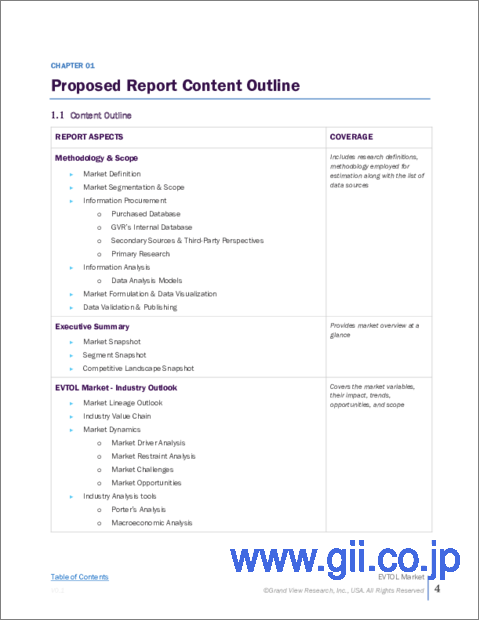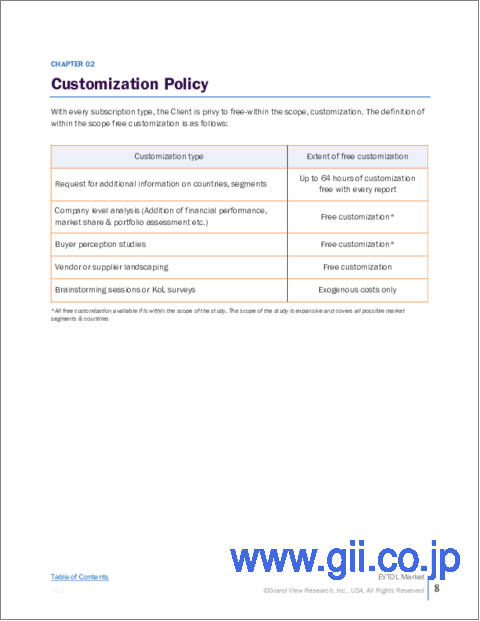|
|
市場調査レポート
商品コード
1530457
eVTOL航空機の市場規模、シェア、動向分析レポート:推進力別、用途別、動作モード別、航続距離別、システム別、地域別、セグメント予測、2024年~2030年eVTOL Aircraft Market Size, Share & Trends Analysis Report By Propulsion, By Application, By Operation Mode, By Range, By System, By Region, And Segment Forecasts, 2024 - 2030 |
||||||
カスタマイズ可能
|
|||||||
| eVTOL航空機の市場規模、シェア、動向分析レポート:推進力別、用途別、動作モード別、航続距離別、システム別、地域別、セグメント予測、2024年~2030年 |
|
出版日: 2024年07月24日
発行: Grand View Research
ページ情報: 英文 150 Pages
納期: 2~10営業日
|
全表示
- 概要
- 図表
- 目次
eVTOL航空機の市場規模と動向
世界のeVTOL航空機市場規模は2023年に13億5,000万米ドルと推定され、2024~2030年にかけて54.9%のCAGRで成長すると予測されています。eVTOL(electric Vertical Takeoff and Landing)航空機市場の成長の大きな要因は、バッテリー技術の開発と改善です。バッテリーがより強力で軽量になり、充電時間を短縮できるようになるにつれて、eVTOLはダウンタイムを短縮しながら長距離を飛行できるようになり、都市部での航空機動やその他の用途でより実用的で魅力的なものになります。この技術的飛躍は、運航効率を向上させ、旅客用ドローンから貨物配送システムまで、eVTOLの可能な使用事例を拡大し、市場成長を促進します。
eVTOL航空機は、化石燃料を動力源とすることが多い地上輸送への依存を大幅に削減することで、環境に優しい都市型航空モビリティの可能性を示しています。より環境に優しい選択肢を求める動きは、金融投資と規制の後押しを電動航空機産業に有利に導き、ひいてはeVTOL航空機市場の拡大を加速させています。
eVTOL設計への自律技術の統合は、市場成長の重要な促進要因です。航空における自律性は、人的ミスを減らすことで安全性を高め、最適化されたルート計画によって効率を高め、最終的にはパイロットを不要にする可能性によって運航コストを削減することができます。人工知能(AI)と機械学習(ML)アルゴリズム、センサー、飛行制御システムの開発が進むことで、将来的には完全自律型のeVTOLサービスに道が開かれ、市場成長に寄与します。
さらに、eVTOL航空機市場の成長には、規制の枠組みの確立と航空当局からの支援が不可欠です。米連邦航空局(FAA)や欧州連合航空安全機関(EASA)などの規制機関は、eVTOL運航に特化したガイドラインや認証の策定に取り組んでいます。このような規制の明確化は、eVTOL航空機の安全性、標準化、社会的信頼を確保するために不可欠です。革新的な航空技術の採用を促進する政府の取り組みや政策も、重要な役割を果たしています。規制がより明確化され、支持されるようになれば、eVTOL航空機の広範な採用と商業運航が促進され、今後数年間の市場拡大が促進されるであろう。
さらに、世界の都市人口の増加とそれに伴う交通渋滞の増加が、eVTOL航空機への需要を高めています。eVTOL航空機は、混雑した都市部の道路を迂回するソリューションを提供し、通勤時間を大幅に短縮して都市住民の生活の質を向上させる。都市が成長し続けるにつれ、eVTOL航空機のような効率的で時間を節約できる交通手段への需要が高まり、市場が前進すると予想されます。
世界のeVTOL航空機市場レポートのセグメンテーション
本レポートでは、2018~2030年にかけての各サブセグメントにおける最新の市場動向と機会の分析とともに、世界、地域、国レベルでの収益成長を推定・予測しています。この調査において、Grand View Research, Inc.は世界のeVTOL航空機市場レポートを推進力、用途、動作モード、航続距離、システム、地域に基づいてさらに細分化しています。
目次
第1章 調査手法と範囲
第2章 エグゼクティブサマリー
第3章 eVTOL航空機市場-業界展望
- 市場概要
- 業界バリューチェーン分析
- 市場力学
- 技術の情勢
- 業界分析ツール
第4章 eVTOL航空機市場:推進力、推定・動向分析
- 推進力の変動分析と市場シェア、2023年と2030年
- 推進力別
第5章 eVTOL航空機市場:用途、推定・動向分析
- 用途の変動分析と市場シェア、2023年と2030年
- 用途別
第6章 eVTOL航空機市場:動作モード、推定・動向分析
- 動作モードの変動分析と市場シェア、2023年と2030年
- 動作モード別
第7章 eVTOL航空機市場:航続距離、推定・動向分析
- 航続距離の変動分析と市場シェア、2023年と2030年
- 航続距離別
第8章 eVTOL航空機市場:システム、推定・動向分析
- システムの変動分析と市場シェア、2023年と2030年
- システム別
第9章 地域別、推定・動向分析
- 地域別eVTOL航空機市場、2023年と2030年
- 北米
- 北米のeVTOL航空機市場の推定と予測、2018~2030年
- 米国
- カナダ
- メキシコ
- 欧州
- 欧州のeVTOL航空機市場の推定と予測、2018~2030年
- ドイツ
- 英国
- フランス
- イタリア
- アジア太平洋
- アジア太平洋のeVTOL航空機市場の推定と予測、2018~2030年
- 日本
- 中国
- インド
- 韓国
- オーストラリア
- ラテンアメリカ
- ラテンアメリカeVTOL航空機市場の推定と予測、2018~2030年
- ブラジル
- 中東・アフリカ
- 中東・アフリカのeVTOL航空機市場の推定と予測、2018~2030年
- サウジアラビア
- アラブ首長国連邦
- 南アフリカ
第10章 eVTOL航空機市場-競合情勢
- 主要市場参入企業による最近の動向と影響分析
- 企業分類
- 参入企業概要
- 企業の市場ポジショニング
- 企業ヒートマップ分析
- 戦略マッピング
- 拡大/売却
- コラボレーション/パートナーシップ
- 新製品の発売
- 研究開発
- 企業プロファイル
- Airbus SE
- Elbit Systems Ltd.
- Bell Textron Inc.
- Workhorse Group, Inc.
- Guangzhou EHang Intelligent Technology Co. Ltd.
- Embraer SA
- BETA Technologies, Inc.
- LIFT Aircraft Inc.
- Israel Aerospace Industries Ltd.
- Volocopter GmbH
List of Tables
- Table 1 Key market driver impact
- Table 2 Key market restraint impact
- Table 3 eVTOL Aircraft Market Revenue Estimates and Forecast, By Propulsion, 2018 - 2030 (USD Million)
- Table 4 eVTOL Aircraft Market Revenue Estimates and Forecast, By Application, 2018 - 2030 (USD Million)
- Table 5 eVTOL Aircraft Market Revenue Estimates and Forecast, by Operation Mode, 2018 - 2030 (USD Million)
- Table 6 eVTOL Aircraft Market Revenue Estimates and Forecast, by Range, 2018 - 2030 (USD Million)
- Table 7 eVTOL Aircraft Market Revenue Estimates and Forecast, by System, 2018 - 2030 (USD Million)
- Table 8 Recent Developments & Impact Analysis, By Key Market Participants
- Table 9 Company Heat Map Analysis
- Table 10 Key companies launching new products
- Table 11 Key companies pursuing expansions
- Table 12 Key companies pursuing mergers & acquisitions
- Table 13 Key companies striking collaborations/partnerships
List of Figures
- Fig. 1 eVTOL Aircraft Market Segmentation
- Fig. 2 Information Procurement
- Fig. 3 Data Analysis Models
- Fig. 4 Market Formulation and Validation
- Fig. 5 Data Validating & Publishing
- Fig. 6 Market Snapshot
- Fig. 7 Segment Snapshot (1/2)
- Fig. 8 Segment Snapshot (2/2)
- Fig. 9 Competitive Landscape Snapshot
- Fig. 10 eVTOL Aircraft Market Value, 2023 & 2030 (USD Million)
- Fig. 11 Industry Value Chain Analysis
- Fig. 12 Market Dynamics
- Fig. 13 PORTER's Analysis
- Fig. 14 PESTEL Analysis
- Fig. 15 eVTOL Aircraft Market, by Propulsion: Key Takeaways
- Fig. 16 eVTOL Aircraft Market, by Propulsion: Market Share, 2023 & 2030
- Fig. 17 Fully Electric Market Estimates & Forecasts, 2018 - 2030 (Revenue, USD Million)
- Fig. 18 Hybrid Market Estimates & Forecasts, 2018 - 2030 (Revenue, USD Million)
- Fig. 19 Electric Hydrogen Market Estimates & Forecasts, 2018 - 2030 (Revenue, USD Million)
- Fig. 20 eVTOL Aircraft Market, by Application: Key Takeaways
- Fig. 21 eVTOL Aircraft Market, by Application: Market Share, 2023 & 2030
- Fig. 22 Cargo Transport Market Estimates & Forecasts, 2018 - 2030 (Revenue, USD Million)
- Fig. 23 Passenger Transport Market Estimates & Forecasts, 2018 - 2030 (Revenue, USD Million)
- Fig. 24 Mapping & Surveying Market Estimates & Forecasts, 2018 - 2030 (Revenue, USD Million)
- Fig. 25 Special Mission Market Estimates & Forecasts, 2018 - 2030 (Revenue, USD Million)
- Fig. 26 Surveillance & Monitoring Market Estimates & Forecasts, 2018 - 2030 (Revenue, USD Million)
- Fig. 27 Others Market Estimates & Forecasts, 2018 - 2030 (Revenue, USD Million)
- Fig. 28 eVTOL Aircraft Market, by Operation Mode: Key Takeaways
- Fig. 29 eVTOL Aircraft Market, by Operation Mode: Market Share, 2023 & 2030
- Fig. 30 Piloted Market Estimates & Forecasts, 2018 - 2030 (Revenue, USD Million)
- Fig. 31 Autonomous Market Estimates & Forecasts, 2018 - 2030 (Revenue, USD Million)
- Fig. 32 eVTOL Aircraft Market, by Range: Key Takeaways
- Fig. 33 eVTOL Aircraft Market, by Range: Market Share, 2023 & 2030
- Fig. 34 Intracity Market Estimates & Forecasts, 2018 - 2030 (Revenue, USD Million)
- Fig. 35 Intercity Market Estimates & Forecasts, 2018 - 2030 (Revenue, USD Million)
- Fig. 36 eVTOL Aircraft Market, by System: Key Takeaways
- Fig. 37 eVTOL Aircraft Market, by System: Market Share, 2023 & 2030
- Fig. 38 Hardware Market Estimates & Forecasts, 2018 - 2030 (Revenue, USD Million)
- Fig. 39 Software Market Estimates & Forecasts, 2018 - 2030 (Revenue, USD Million)
- Fig. 40 eVTOL Aircraft Market Revenue by Region, 2023 & 2030 (USD Million)
- Fig. 41 Regional Marketplace: Key Takeaways
- Fig. 42 North America eVTOL Aircraft Market Estimates & Forecasts, 2018 - 2030 (Revenue, USD Million)
- Fig. 43 U.S. eVTOL Aircraft Market Estimates & Forecasts, 2018 - 2030 (Revenue, USD Million)
- Fig. 44 Canada eVTOL Aircraft Market Estimates & Forecasts, 2018 - 2030 (Revenue, USD Million)
- Fig. 45 Mexico eVTOL Aircraft Market Estimates & Forecasts, 2018 - 2030 (Revenue, USD Million)
- Fig. 46 Europe eVTOL Aircraft Market Estimates & Forecasts, 2018 - 2030 (Revenue, USD Million)
- Fig. 47 Germany eVTOL Aircraft Market Estimates & Forecasts, 2018 - 2030 (Revenue, USD Million)
- Fig. 48 UK eVTOL Aircraft Market Estimates & Forecasts, 2018 - 2030 (Revenue, USD Million)
- Fig. 49 France eVTOL Aircraft Market Estimates & Forecasts, 2018 - 2030 (Revenue, USD Million)
- Fig. 50 Italy eVTOL Aircraft Market Estimates & Forecasts, 2018 - 2030 (Revenue, USD Million)
- Fig. 51 Asia Pacific eVTOL Aircraft Market Estimates & Forecasts, 2018 - 2030 (Revenue, USD Million)
- Fig. 52 China eVTOL Aircraft Market Estimates & Forecasts, 2018 - 2030 (Revenue, USD Million)
- Fig. 53 Japan eVTOL Aircraft Market Estimates & Forecasts, 2018 - 2030 (Revenue, USD Million)
- Fig. 54 South Korea eVTOL Aircraft Market Estimates & Forecasts, 2018 - 2030 (Revenue, USD Million)
- Fig. 55 India eVTOL Aircraft Market Estimates & Forecasts, 2018 - 2030 (Revenue, USD Million)
- Fig. 56 Australia eVTOL Aircraft Market Estimates & Forecasts, 2018 - 2030 (Revenue, USD Million)
- Fig. 57 Latin America eVTOL Aircraft Market Estimates & Forecasts, 2018 - 2030 (Revenue, USD Million)
- Fig. 58 Brazil eVTOL Aircraft Market Estimates & Forecasts, 2018 - 2030 (Revenue, USD Million)
- Fig. 59 Middle East & Africa eVTOL Aircraft Market Estimates & Forecasts, 2018 - 2030 (Revenue, USD Million)
- Fig. 60 UAE eVTOL Aircraft Market Estimates & Forecasts, 2018 - 2030 (Revenue, USD Million)
- Fig. 61 Saudi Arabia eVTOL Aircraft Market Estimates & Forecasts, 2018 - 2030 (Revenue, USD Million)
- Fig. 62 South Africa eVTOL Aircraft Market Estimates & Forecasts, 2018 - 2030 (Revenue, USD Million)
- Fig. 63 Key Company Categorization
- Fig. 64 Company Market Positioning
- Fig. 65 Strategic framework
eVTOL Aircraft Market Size & Trends
The global eVTOL aircraft market size was estimated at USD 1.35 billion in 2023 and is expected to grow at a CAGR of 54.9% from 2024 to 2030. The development and improvement in battery technologies are significant drivers for the eVTOL (electric Vertical Takeoff and Landing) aircraft market growth. As batteries become more powerful, lighter, and capable of faster charging times, eVTOLs can fly longer distances with shorter downtimes, making them more practical and appealing for urban air mobility and other applications. This technological leap enhances operational efficiency and expands the possible use cases for eVTOLs, from passenger drones to cargo delivery systems, thereby driving market growth.
Moreover, with global awareness and governmental policies shifting towards reducing carbon emissions and combating climate change, there's a growing demand for sustainable transport solutions. eVTOL aircraft represent a potential for eco-friendly urban air mobility by considerably reducing the reliance on ground transportation, which is often powered by fossil fuels. The push for more environment-friendly options is guiding financial investments and regulatory backing in favor of the electric aviation industry, which, in turn, is accelerating the expansion of the eVTOL aircraft market.
The integration of autonomous technologies into eVTOL designs is a significant driver for the market growth. Autonomy in aviation can increase safety by reducing human error, enhance efficiency through optimized route planning, and eventually reduce operational costs by potentially eliminating the need for pilots. The ongoing development of Artificial Intelligence (AI) and Machine Learning (ML) algorithms, sensors, and flight control systems paves the way for fully autonomous eVTOL services in the future, contributing to market growth.
Additionally, the establishment of regulatory frameworks and support from aviation authorities is crucial for the growth of the eVTOL market. Regulatory bodies such as the Federal Aviation Administration (FAA) and European Union Aviation Safety Agency (EASA) are working on developing guidelines and certifications specific to eVTOL operations. This regulatory clarity is essential for ensuring safety, standardization, and public trust in eVTOL aircraft. Government initiatives and policies that promote the adoption of innovative aviation technologies are also playing a significant role. As regulations become more defined and supportive, they will facilitate the wider adoption and commercial operation of eVTOL aircraft, driving market expansion in the coming years.
Furthermore, the global increase in urban population and the consequent rise in traffic congestion are increasing demand for eVTOL aircrafts. eVTOL aircraft offer a solution to bypass crowded urban streets, significantly reducing commute times and improving the quality of life for city residents. As cities continue to grow, the demand for efficient, time-saving transportation options like eVTOL aircraft is expected to rise, propelling the market forward.
Global eVTOL Aircraft Market Report Segmentation
This report forecasts and estimates revenue growth at the global, regional, and country levels along with analyzes the latest market trends and opportunities in each one of the sub-segments from 2018 to 2030. For this study, Grand View Research has further segmented the global eVTOL aircraft market report based on propulsion, application, operation mode, range, system, and region.
- Propulsion Outlook (Revenue, USD Million, 2018 - 2030)
- Fully Electric
- Hybrid
- Electric Hydrogen
- Application Outlook (Revenue, USD Million, 2018 - 2030)
- Cargo Transport
- Passenger Transport
- Mapping & Surveying
- Special Mission
- Surveillance & Monitoring
- Others
- Operation Mode Outlook (Revenue, USD Million, 2018 - 2030)
- Piloted
- Autonomous
- Range Outlook (Revenue, USD Million, 2018 - 2030)
- Intracity (20km-100km)
- Intercity (Above 100Km)
- System Outlook (Revenue, USD Million, 2018 - 2030)
- Hardware
Aerostructure
Avionics
Electric Motor
Batteries and Fuel Cells
Others
- Software
- Regional Outlook (Revenue, USD Million, 2018 - 2030)
- North America
U.S.
Canada
Mexico
- Europe
Germany
UK
France
Italy
- Asia Pacific
Japan
China
India
Australia
South Korea
- Latin America
Brazil
- Middle East and Africa (MEA)
UAE
Saudi Arabia
South Africa
Table of Contents
Chapter 1. Methodology and Scope
- 1.1. Market Segmentation & Scope
- 1.2. Market Definitions
- 1.3. Information Procurement
- 1.3.1. Information analysis
- 1.3.2. Market formulation & data visualization
- 1.3.3. Data validation & publishing
- 1.4. 4 Research Scope and Assumptions
- 1.4.1. List to Data Sources
Chapter 2. Executive Summary
- 2.1. eVTOL Aircraft Market Snapshot
- 2.2. eVTOL Aircraft Market- Segment Snapshot (1/2)
- 2.3. eVTOL Aircraft Market- Segment Snapshot (2/2)
- 2.4. eVTOL Aircraft Market- Competitive Landscape Snapshot
Chapter 3. eVTOL Aircraft Market - Industry Outlook
- 3.1. Market Overview
- 3.2. Industry Value Chain Analysis
- 3.3. Market Dynamics
- 3.3.1. Market Driver Analysis
- 3.3.2. Market Restraint Analysis
- 3.3.3. Market Opportunity
- 3.4. Technology Landscape
- 3.5. Industry Analysis Tools
- 3.5.1. Porter's analysis
- 3.5.2. Macroeconomic analysis
Chapter 4. eVTOL Aircraft Market: Propulsion Estimates & Trend Analysis
- 4.1. Propulsion Movement Analysis & Market Share, 2023 & 2030
- 4.2. eVTOL Aircraft Market Estimates & Forecast, By Propulsion (USD Million)
- 4.2.1. Fully Electric
- 4.2.2. Hybrid
- 4.2.3. Electric Hydrogen
Chapter 5. eVTOL Aircraft Market: Application Estimates & Trend Analysis
- 5.1. Application Movement Analysis & Market Share, 2023 & 2030
- 5.2. eVTOL Aircraft Market Estimates & Forecast, By Application (USD Million)
- 5.2.1. Cargo Transport
- 5.2.2. Passenger Transport
- 5.2.3. Mapping & Surveying
- 5.2.4. Special Mission
- 5.2.5. Surveillance & Monitoring
- 5.2.6. Others
Chapter 6. eVTOL Aircraft Market: Operation Mode Estimates & Trend Analysis
- 6.1. Operation Mode Movement Analysis & Market Share, 2023 & 2030
- 6.2. eVTOL Aircraft Market Estimates & Forecast, By Operation Mode (USD Million)
- 6.2.1. Piloted
- 6.2.2. Autonomous
Chapter 7. eVTOL Aircraft Market: Range Estimates & Trend Analysis
- 7.1. Range Movement Analysis & Market Share, 2023 & 2030
- 7.2. eVTOL Aircraft Market Estimates & Forecast, By Range (USD Million)
- 7.2.1. Intracity (20km-100km)
- 7.2.2. Intercity (Above 100Km)
Chapter 8. eVTOL Aircraft Market: System Estimates & Trend Analysis
- 8.1. System Movement Analysis & Market Share, 2023 & 2030
- 8.2. eVTOL Aircraft Market Estimates & Forecast, By System (USD Million)
- 8.2.1. Hardware
- 8.2.1.1. Aerostructure
- 8.2.1.2. Avionics
- 8.2.1.3. Electric Motor
- 8.2.1.4. Batteries and Fuel Cells
- 8.2.1.5. Others
- 8.2.2. Software
- 8.2.1. Hardware
Chapter 9. Regional Estimates & Trend Analysis
- 9.1. eVTOL Aircraft Market by Region, 2023 & 2030
- 9.2. North America
- 9.2.1. North America eVTOL Aircraft Market Estimates & Forecasts, 2018 - 2030 (USD Million)
- 9.2.2. U.S.
- 9.2.3. Canada
- 9.2.4. Mexico
- 9.3. Europe
- 9.3.1. Europe eVTOL Aircraft Market Estimates & Forecasts, 2018 - 2030 (USD Million)
- 9.3.2. Germany
- 9.3.3. U.K.
- 9.3.4. France
- 9.3.5. Italy
- 9.4. Asia Pacific
- 9.4.1. Asia Pacific eVTOL Aircraft Market Estimates & Forecasts, 2018 - 2030 (USD Million)
- 9.4.2. Japan
- 9.4.3. China
- 9.4.4. India
- 9.4.5. South Korea
- 9.4.6. Australia
- 9.5. Latin America
- 9.5.1. Latin America eVTOL Aircraft Market Estimates & Forecasts, 2018 - 2030 (USD Million)
- 9.5.2. Brazil
- 9.6. Middle East & Africa (MEA)
- 9.6.1. MEA eVTOL Aircraft Market Estimates & Forecasts, 2018 - 2030 (USD Million)
- 9.6.2. Saudi Arabia
- 9.6.3. UAE
- 9.6.4. South Africa
Chapter 10. eVTOL Aircraft Market - Competitive Landscape
- 10.1. Recent Developments & Impact Analysis, By Key Market Participants
- 10.2. Company Categorization
- 10.3. Participant's Overview
- 10.4. Financial Performance
- 10.5. Product Benchmarking
- 10.6. Company Market Positioning
- 10.7. Company Heat Map Analysis
- 10.8. Strategy Mapping
- 10.8.1. Expansion/Divestiture
- 10.8.2. Collaborations/Partnerships
- 10.8.3. New Product Launches
- 10.8.4. Research & Development
- 10.9. Company Profiles
- 10.9.1. Airbus S.E.
- 10.9.1.1. Participant's Overview
- 10.9.1.2. Financial Performance
- 10.9.1.3. Product Benchmarking
- 10.9.1.4. Recent Developments
- 10.9.2. Elbit Systems Ltd.
- 10.9.2.1. Participant's Overview
- 10.9.2.2. Financial Performance
- 10.9.2.3. Product Benchmarking
- 10.9.2.4. Recent Developments
- 10.9.3. Bell Textron Inc.
- 10.9.3.1. Participant's Overview
- 10.9.3.2. Financial Performance
- 10.9.3.3. Product Benchmarking
- 10.9.3.4. Recent Developments
- 10.9.4. Workhorse Group, Inc.
- 10.9.4.1. Participant's Overview
- 10.9.4.2. Financial Performance
- 10.9.4.3. Product Benchmarking
- 10.9.4.4. Recent Developments
- 10.9.5. Guangzhou EHang Intelligent Technology Co. Ltd.
- 10.9.5.1. Participant's Overview
- 10.9.5.2. Financial Performance
- 10.9.5.3. Product Benchmarking
- 10.9.5.4. Recent Developments
- 10.9.6. Embraer S.A.
- 10.9.6.1. Participant's Overview
- 10.9.6.2. Financial Performance
- 10.9.6.3. Product Benchmarking
- 10.9.6.4. Recent Developments
- 10.9.7. BETA Technologies, Inc.
- 10.9.7.1. Participant's Overview
- 10.9.7.2. Financial Performance
- 10.9.7.3. Product Benchmarking
- 10.9.7.4. Recent Developments
- 10.9.8. LIFT Aircraft Inc.
- 10.9.8.1. Participant's Overview
- 10.9.8.2. Financial Performance
- 10.9.8.3. Product Benchmarking
- 10.9.8.4. Recent Developments
- 10.9.9. Israel Aerospace Industries Ltd.
- 10.9.9.1. Participant's Overview
- 10.9.9.2. Financial Performance
- 10.9.9.3. Product Benchmarking
- 10.9.9.4. Recent Developments
- 10.9.10. Volocopter GmbH
- 10.9.10.1. Participant's Overview
- 10.9.10.2. Financial Performance
- 10.9.10.3. Product Benchmarking
- 10.9.10.4. Recent Developments
- 10.9.1. Airbus S.E.






